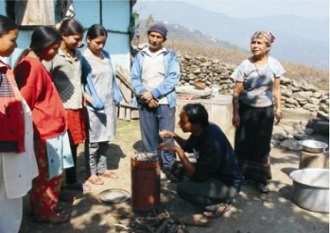October 03 2010 – $2 billion a year market in India for clever techies
Analysis finds that companies supplying clean energy products–including solar lanterns and energy efficient cooking stoves–to the rural market, have seen annual gross revenue grow by an average of 36 per cent per year since 2004.
While rural electrification in India has been growing in recent years, this growth has come at a very slow rate. Moreover, most rural areas only receive a few hours of electricity a day, which is of a very low voltage.
The market for clean energy products and services is increasing among India’s rural poor, and according to a new analysis, could potentially grow to more than $2 billion per year.
Demand for clean energy products is rising among India’s rural communities, according to the Power to the People analysis released by the Centre for Development Finance at the Institute for Financial Management and Research (CDF-IFMR) and the World Resources Institute(WRI).
The study focuses on the energy needs of India’s rural poor, or those living at the Base of the Pyramid (BoP) in rural areas, which make up more than 114 million households and nearly 60 per cent of India’s total population. The analysis finds that companies supplying clean energy products–including solar lanterns and energy efficient cooking stoves–to the rural BoP market, have seen annual gross revenue grow by an average of 36 per cent per year since 2004.
“Clean energy firms in India can capture the market that serves the BoP by providing environmentally and user-friendly energy solutions that will reduce health problems through lower air pollution, and lower fuel costs, while generating additional public benefits, such as lower greenhouse gas emissions,” said Kirsty Jenkinson, director of the Markets and Enterprise Program at WRI. “This report will help investors recognise the tremendous market opportunities in this nascent, but fast-growing sector.”
To estimate the current state of India’s clean energy market and potential for growth, CDF-IFMR and WRI conducted field research among rural BoP consumers in 26 small towns and villages in India and across four other countries. The teams also collected financial data from 15 Indian companies across four sectors–small decentralised renewable electricity producers, home-scale solar electricity providers, solar-powered lantern manufacturers, and energy-efficient cooking stove producers.
While rural electrification in India has been growing in recent years, this growth has come at a very slow rate. Moreover, most rural areas only receive a few hours of electricity a day, which is of a very low voltage. Households connected to the grid often find that the electricity is of poor quality and, according to those interviewed, the rural BoP want a dependable source of electricity.
“Most people we talked to in rural communities consider energy to be essential,” said Saurabh Lall, a research officer at WRI. “If there are high quality renewable products and services that meet consumer demand available, there is a market for them, even in the very poorest communities.”
Currently, the Indian BoP is spending $4.8 billion per year on energy, mainly for fuels that are harmful to the environment and hazardous to personal health as well as for services that are unreliable. Installed at the community level, small hydro and biomass gasification can supply energy to a local area without depending on the grid. At the individual level, solar lanterns and energy-efficient cook stoves can replace dirty fuel sources such as kerosene lamps and cooking stoves fired by wood or dung. The transition to clean energy sources among India’s rural poor offers significant growth potential for investors while also promising to provide tangible environmental, health and lifestyle benefits to the rural BoP in India.
“Eliminating energy poverty in a sustainable way is one of the most significant development challenges of our time,” said Jessica Seddon Wallack, Director, Centre for Development Finance. “We require innovation at all levels, from lowering the costs of renewable technologies to creating business and policy models for generating and disseminating energy and ensuring its efficient use to understanding the intricacies of consumer demand.”
http://www.cpifinancial.net/v2/News.aspx?v=1&aid=6158&sec=Alternative%20Investments



